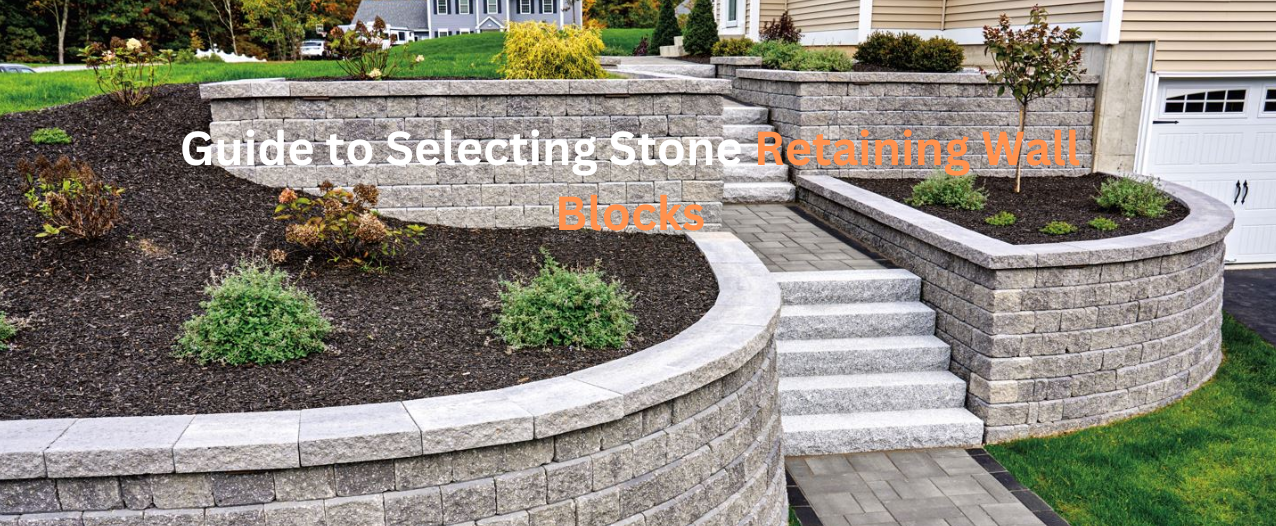As a sandstone manufacturer and supplier, clients often ask us about their queries regarding garden walls and materials. Because the garden is one of the most eye-catching and closest to the nature portion of any premise, no one would like to miss the opportunity to give it a perfect charm.
Out of several means of garden decor, retaining walls are one of them. These walls bring both beauty and utility with them. Using stone retaining wall blocks not only protects your garden from soil erosion but also upgrades its looks. With a well-structured uniform look, your garden appears more authentic.
Once you know that you need retaining walls, it becomes important to consider some major factors that influence the decision of selecting stone retaining wall blocks. Here in this blog, we have covered those factors for you so you don’t need to worry anymore. Dive in to get the best idea.
Key Considerations When Selecting Stone Retaining Wall Blocks
When it comes to home decor with utility, you should not make a causal decision. You need to do proper research and go through some trusted sources before purchasing sandstone blocks for retaining walls. Here we will discuss some of those important factors that you would not like to miss before spending any penny.
Purpose of the Retaining Wall
Another factor to consider while selecting stone retaining wall blocks is why you need a retaining wall. Whether you need a wall for decorative purposes or you need it to check soil erosion, each condition would ask for a different kind of sandstone block. So let’s have a look at various sandstone wall requirements and preferred blocks.
- Erosion Control: If the primary focus behind sandstone walling is to check soil erosion, then you need a block with some density. For this task, choosing a granite block would be a great decision.
- Decorative Walls: If visual appeal is what you are looking for, then a limestone block or sand brick block would be a great option. These blocks fit well with the sandstone retaining wall design.
- Terracing and Raised Garden Beds: While terracing or building garden beds, you can try stone brick blocks or sandstone blocks. For small-scale projects, these blocks are best.
Matching Stone Blocks to Soil Conditions
While dealing with stone retaining wall blocks, taking the soil under consideration should be the first step. In a country like Australia, you will find different soil conditions, and each kind of soil interacts with a different type of block. So let’s have a look at different types of soils and suitable blocks for them.
- Clay Soils: Clay soil is more prone to expanding with water retention. In such cases, high-density blocks like granite blocks are ideal, as they hold great strength and resistance to compression.
- Sandy Soils: This soil is known for its sifting ability with time. Here, a limestone block retaining wall can bring stability with its natural grip and texture.
- Loamy Soils: Loamy soil holds more moisture and humus in comparison with sandy soil and better drainage compared to clay and silt soil. Sandstone blocks go well with this kind of soil.
Selecting the Right Stone Blocks for Different Wall Types
According to your requirements, you would choose a preferred wall type, and that decision would affect the selection of stone-retaining wall blocks. To get the required stability and look, you have to choose the block that suits your wall type. So let’s get some idea about different wall types and their desirable wall blocks.
- Gravity Walls: These walls are known for fighting the pressure from soil with their mass. To fulfil the mass-related need, a granite block would be a perfect fit.
- Dry-Stacked Walls: Being constructed with mortar becomes the reason for these walls to opt for stacking from stone. A limestone would suit these types of walls perfectly.
- Garden Walls: When the focus of the wall is more on visual appeals than preventing soil, then a block-like stone brick comes into the action. These blocks are the best option for fulfilling your aesthetic desires.
Climate and Weather Conditions
While selecting sandstone blocks for retaining walls, one important factor that needs your attention is the climate and weather. The climate and weather in your area surely need some specific types of blocks. Let’s discuss some of those weather and wall block combinations.
- Freezing and Thawing Cycles: In extreme cold areas, where the temperature goes below freezing point, granite or bluestone blocks could be a great choice. These blocks come with low porosity and resistance to cracking.
- High Moisture Areas: In areas with high rainfall, you need a stone that is resistant to water absorption and erosion. Sandstone and granite blocks could play this role superlatively.
- Coastal Environments: In coastal areas, where sandstone walls deal with both salt and moisture at once, granite blocks could be the most preferable choice.
Closing Curtains
A combination of utility and beauty—that is what stone retaining wall blocks serve you, and to get the best out of it, careful consideration becomes unavoidable. We have discussed all the major factors that would ask for attention before the selection of stone blocks. From soil type to wall type, we have covered everything, so you say that this blog is bestowed with all the necessary intel.
To explore a wide range of the finest sandstone products visit Maroota Sandstone Quarry right away. We are one of the finest Australian Sandstone Merchants with our top-notch, flawless services. Contact us today for your sandstone product requirements.
FAQ Section
Q1.How to clean sandstone walls?
Answer: Sandstone walls should be gently cleansed with a gentle brush and a light detergent; avoid using harsh chemicals, since they might harm the stone. Moss and algae growth is discouraged by frequent washing, which also retains their inherent beauty.
Q2. How to cut stone retaining wall blocks?
Answer: Accurately cut stone blocks with a masonry saw or chisel and hammer while wearing safety gear to ensure your safety. To put blocks tightly within your retaining wall design, precision is essential.
Q3. Which retaining wall blocks are best for curved designs?
Answer: Use interlocking blocks or specifically made curved retaining wall blocks bunnings for curved retaining walls. It is simpler to shape and arrange these blocks to create beautiful, flowing shapes.
Q4. What is the most durable material for retaining wall blocks?
Answer: Granite is one of the strongest and longest-lasting materials for retaining walls, but concrete blocks are also quite durable and versatile.
Q5. Can I build a retaining wall myself, or should I hire a professional?
Answer: Smaller walls can be built by hand, but larger or more structurally complex buildings, particularly in challenging terrain, require the expertise of a professional to ensure long-term stability and safety.




